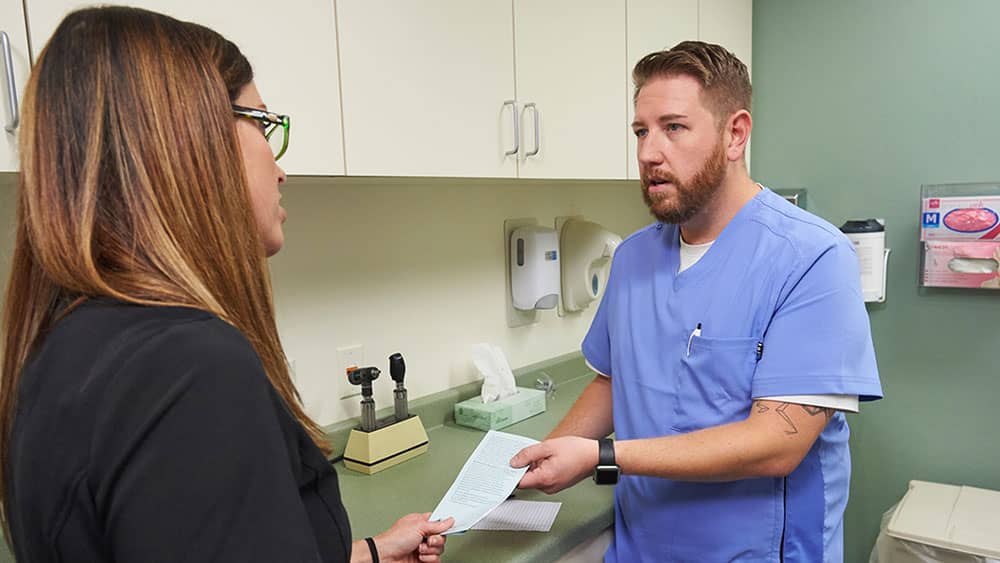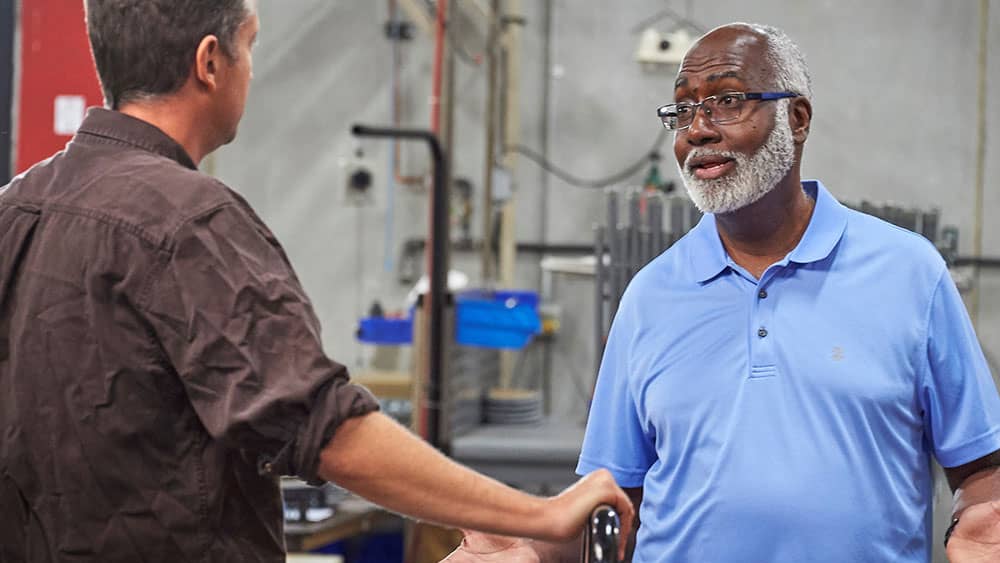Sexual Harassment Prevention Training
Empower bystanders to stand up to sexual harassment and promote a safe, respectful workplace with Sexual Harassment Prevention Training. Developed in cooperation with a leading researcher, this unique program will help your employees prevent sexual harassment, and, in the event it does occur, respond swiftly and appropriately.

Everyone wants to feel respected and safe in their workplace. When an employee experiences sexual harassment, their sense of respect and safety is violated. But what is sexual harassment, exactly?
You've likely heard a lot about sexual harassment in the news. These stories may differ in their details, but one common theme is shared by all of them — an abuse of power that manifests in a sexual or sex-based way. We can all agree that abuses of power are wrong. For instance, it is wrong for someone with power over financial matters in a company to abuse that power by embezzling funds from the company. It is also wrong for someone with social power over coworkers or subordinates to subject those people to unwanted sexual or otherwise disrespectful behaviors that target them because they happen to be a man or a woman.
The tricky part about sexual harassment is that those with power sometimes don't recognize when they are abusing it and that those without power are reluctant to speak up for fear of workplace consequences. This training session will help you sort out not just which behaviors are likely to be sexual harassment, but the techniques you can use in response to those behaviors in order to help keep your workplace respectful and safe.
There are multiple definitions of sexual harassment, and all of them contain a degree of subjectivity. Recognize that sexual harassment is not a black and white issue, it involves subjective experiences. A behavior that is fun or funny in one work group could be offensive and threatening in another. That's why employees need to use communication and conflict management skills so they can have the difficult conversations that help maintain professional norms in their work environments.
Sexual Harassment Prevention Training Curriculum
J. J. Keller's Sexual Harassment Prevention training is a five-part series designed to help prevent sexual harassment from happening in the first place. Two additional add-on modules are available for managers and those who work in retail environments. And, in the unfortunate event harassment does occur, learners will be prepared to respond swiftly and appropriately to the situation.
Sexual Harassment Prevention: What is Sexual Harassment?
Sexual harassment training helps learners understand what sexual harassment is, where it can happen, who it can happen to, and possible consequences for all involved.
Sexual Harassment Prevention: Civility in the Workplace
Sexual harassment training helps learners understand what is crossing the line when it comes to sexual harassment, how to treat others with respect and hold each other accountable, and how to put an end to "normalizing"
Sexual Harassment Prevention: Taking Action
This sexual harassment training helps bystanders understand how to stop the harassment, console the victim, document the situation, and report it to the appropriate people.
Sexual Harassment Prevention: Addressing Harassment
This sexual harassment training helps learners determine if something is considered sexual harassment, how to confront the harasser, how to document the situation, how to follow workplace policy and how to take the situation to the next level if necessary.
Sexual Harassment Prevention: What Happens Next?
This sexual harassment training helps learners understand what happens after a sexual harassment situation has been reported, possible retaliation situations, and how to move on afterward.
Sexual Harassment Prevention: Additional Management Responsibilities
This sexual harassment training module helps management understand that preventing sexual harassment starts with them, and teaches them out to respond to a report and how to move on afterward.
Sexual Harassment Prevention: Additional Training for Retail Environments
This sexual harassment prevention training will teach employees how to recognize illegal behavior from coworkers and customers, and how to respond in the unfortunate event that it does occur.
This training content is available to download in SCORM 1.2 or MP4 formats for use on your own Learning Management System or company intranet. Learn More
-
Create a Safe and Respectful Workplace Environment
- START TRAINING FOR FREE
"I recommend this training..."

… to any company looking to prevent sexual harassment with an evidence-based product that builds up employees’ competencies for bystander intervention. The bystander approach is based on my own research on employee reactions to sexual harassment training and is designed to reduce backlash reactions to training. J. J. Keller’s training doesn’t stop at presenting the legal definitions; it helps employees understand the social complexity of sexual harassment and ways to establish respectful workgroup norms.
Shannon L. Rawski, Ph.D.
Expert in Sexual Harassment & Sexual Harassment Training
Dr. Shannon L. Rawski is an assistant professor of Human Resource Management at University of Wisconsin - Oshkosh and a consultant at Thrive Mind Consulting, LLC, specializing in assessing and improving sexual harassment training effectiveness. Her research was featured at TEDxOshkosh and has been cited by popular media such as the The New York Times, The Washington Post, The Wall Street Journal, Fortune Magazine and more.
Additional State-Specific Training Requirements
Click the links below to learn more about the sexual harassment prevention training and education required by individual states:
Note: States may have more requirements than are listed here. Requirements not listed here are already met within the Sexual Harassment Prevention Training Program.
Beginning January 1, 2019; initial training must be complete by January 1, 2021.
Covered employers: Those with 5 or more employees (this count includes temporary, seasonal, migrant, or agricultural workers as well as non-California-based employees, independent contractors, volunteers, or unpaid interns)
[Note: An employer is required to train its California-based employees so long as it employs 5 or more employees anywhere, even if they do not work at the same location and even if not all of them work or reside in California.]
Who must be trained: All California-based employees (not including non-California-based employees, independent contractors, volunteers, or unpaid interns —these employees count toward the number of employees but do not require training)
Training length: 1 hour for employees, 2 hours for supervisors
Frequency of training: Every two years
Interactive component required: Yes
New-hire training deadline: Within 6 months of hire; For employees expected to work less than 6 months, training must be completed within 30 calendar days or 100 hours worked, whichever comes first
In order to be compliant with state requirements, training must include the following information:
- A definition of unlawful sexual harassment under the Fair Employment and Housing Act (FEHA) (use definition from first FAQ – “What is sexual harassment?”)
- A statement that abusive conduct is illegal, and the definition of abusive contact as found in Government Code section 12950.1, subdivision (i)(2) (copy the definition starting with “conduct of an employer…”
- Company complaint process and contact information for individuals to whom victims should report harassment (provided by employer)
- State contact information for individuals to whom victims should report harassment (at minimum, provide employees with this website, email [contact.center@dfeh.ca.gov], and phone number for the Department of Fair Employment and Housing - 800-884-1684 [voice], 800-700-2320 [TTY])
- Instructions on how to contact a qualified trainer who can answer questions within two business days (provided by employer)
- Anti-harassment policy – either the employer's or a sample (provided by employer)
In order to satisfy California time and interactivity requirements, employers should use the full Sexual Harassment Prevention program and interactive materials in conjunction with the supplementary information noted above.
Beginning October 1, 2019; initial training must be complete by October 1, 2020.
Covered employers: All
Who must be trained: All employers must train supervisors; Those with 3 or more employees must train all employees and supervisors
Training length: 2 hours
Frequency of training: Every 10 years
Interactive component required: No
New-hire training deadline: Within 6 months of hire
In order to be compliant with state requirements, training must include the following information:
- Exact definition of sexual harassment as set forth in (8) of subsection (a) of section 46a-60 of the Connecticut General Statutes (copy the definition beginning in the second sentence with “Any unwelcome…”)
- Instructions on how to ask questions and obtain prompt answers from employer or trainer (provided by employer)
- A statement that remedies available to victims of sexual harassment may include, but are not limited to, cease and desist orders; hiring, promotion or reinstatement; compensatory damages and back pay (employers may add other company-specific remedies)
- A statement that individuals who commit acts of sexual harassment may be subject to both civil and criminal penalties
- Company complaint process and contact information for individuals to whom victims should report harassment (provided by employer)
- State contact information for individuals to whom victims should report harassment (at minimum, provide employees with this website and phone number for the Connecticut Commission on Human Rights and Opportunities – 860-541-3400 [phone], 860-541-3459 [TDD])
In order to satisfy Connecticut time requirements, employers should use the full Sexual Harassment Prevention program and interactive materials in conjunction with the supplementary information noted above.
Beginning January 1, 2019; initial training must be complete by January 1, 2020.
Covered employers: Those with 50 or more employees working in Delaware (including seasonal and temporary employees)
Who must be trained: All employees
Training length: Not specified
Frequency of training: Every 2 years
Interactive component required: Yes
New-hire training deadline: Within 1 year of hire
In order to be compliant with state requirements, training must include the following information:
- Company complaint process and contact information for individuals to whom victims should report harassment (provided by employer)
- State contact information for individuals to whom victims should report harassment (at minimum, provide employees with this website and phone numbers for Delaware Department of Labor Office of Anti-Discrimination – 302-761-8200 or 302-424-1134)
In order to satisfy Delaware interactivity requirements, employers should use the full Sexual Harassment Prevention program and interactive materials in conjunction with the supplementary information noted above.
Beginning January 1, 2020, employers must provide sexual harassment training to all employees on an annual basis.
Covered employers: All
Who must be trained: All employees
Training length: Not specified
Frequency of training: Annually
Interactive component required: No
New-hire training deadline: Not specified
In order to be compliant with state requirements, training must include the following information:
- A statement that sexual harassment is illegal under the Illinois Human Rights Act
- A summary of responsibilities of employers in the prevention, investigation, and corrective measures of sexual harassment (this is provided in Module 6: Additional Management Responsibilities of the Sexual Harassment Prevention program, which should be distributed to all employees to meet this requirement)
- Company complaint process and contact information for individuals to whom victims should report harassment (provided by employer)
- Details of legal recourse and complaint process available through the Illinois Department of Human Rights (at minimum, provide employees with information provided on this website and phone number for the Illinois Department of Human Rights – 312-814-6200 [Chicago phone], 217-785-5100 [Springfield phone], 866-740-3953 [statewide TTY])
Employers in the restaurant and bar industry must also include supplemental training that includes:
- Examples of illegal conduct and discussions of sexual harassment related specifically to the restaurant/bar industry (provided by employer)
In order to satisfy Illinois interactivity requirements, employers should use the full Sexual Harassment Prevention program and interactive materials in conjunction with the supplementary information noted above.
Covered employers: Those with 15 or more employees
Who must be trained: All employees
Training length: Not specified
Frequency of training: Every 2 years
Interactive component required: Yes
New-hire training deadline: Within 1 year of hire
In order to be compliant with Maine requirements, training must include the following information:
- A statement that sexual harassment is illegal under the Maine Human Rights Act, as defined in the training
- Additional information regarding protections from retaliation as outlined in Title 5, section 4553, subsection 10 (“Unlawful discrimination”), paragraph D (Provide copy of paragraph D [“Aiding, abetting…”] of subsection 10 [“Unlawful discrimination”])
- Company complaint process and contact information for individuals to whom victims should report harassment (provided by employer)
- Details of legal recourse and complaint process available through the Maine Human Rights Commission (at minimum, provide employees with information provided on this website and phone number for the Main Human Rights Commission – 207-624-6290)
In order to satisfy Maine interactivity requirements, employers should use the full Sexual Harassment Prevention program and interactive materials in conjunction with the supplementary information noted above.
Beginning October 8, 2018, initial training must be complete by October 9, 2019. Subsequent annual training may be based on calendar year, employee start date, or any other date the employer chooses.
Covered employers: All
Who must be trained: All employees (including seasonal and temporary workers)
Training length: Not specified
Frequency of training: Annually
Interactive component required: Yes
New-hire training deadline: As soon as possible (exact timing not specified)
In order to be compliant with state requirements, training must include the following information:
- A statement for supervisors that reporting sexual harassment, once they observe or become aware of it, is mandatory in New York (this information should be provided to all employees)
- Company complaint process and contact information for individuals to whom victims should report harassment (provided by employer)
- State contact information for individuals to whom victims should report harassment (at minimum, provide employees with this website, email [complaints@dhr.ny.gov], and phone number for the Division of Human Rights – 718-741-8332 [phone], 718-741-8300 [TTY])
- A sexual harassment policy that includes a complaint form for employees (employers may use the models provided or create their own)
In order to satisfy interactivity requirements, employers should use the full Sexual Harassment Prevention program and interactive materials in conjunction with the supplementary information noted below.
From Our Customers...
The training was great! It dealt with the each portion adequately. It was not very lengthy and kept the attention of our staff with the great scenarios. Very effective and to the point, easy to understand and follow along with.
Why J. J. Keller® Training?
ROBUST ONLINE TRAINING LIBRARY
Access the industry’s largest online training library, consisting of 950+ unique E-Learning courses, 500+ customizable training resources, and more.
STREAMING VIDEO FOR ADDED IMPACT
Make the most of your classroom training sessions with 300+ hi-res training videos developed by adult learning specialists.
EASY ACCESS ANYTIME, ANYWHERE
Enjoy maximum flexibility with 24/7 access to hundreds of titles through our mobile-friendly site, plus a free app for learners to train on the go.
EXPERT CONTENT YOU CAN TRUST
Backed by 70 years of industry experience, our courses center on actionable learning objectives and receive regular updates from our in-house experts to reflect the latest regulatory changes.
FREE RECORDKEEPING AND REPORTING
Easily track which employees have been trained on which topics and when, and identify any lapses in your training program – at no added cost.
INVALUABLE MANAGEMENT RESOURCES
As an administrator, you’ll gain exclusive access to the J. J. Keller® Reference Hub, where you can reference word-for-word regulations, ask our experts specific compliance questions, and more.






